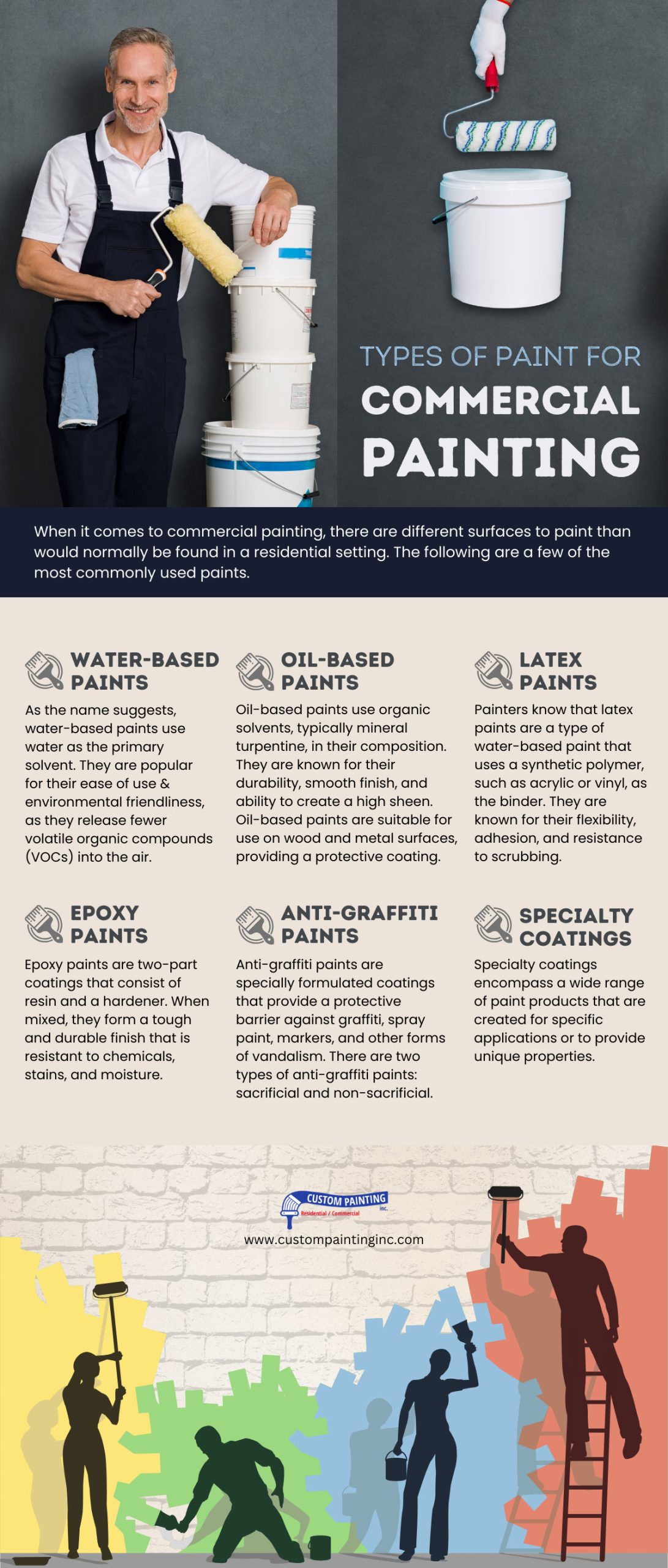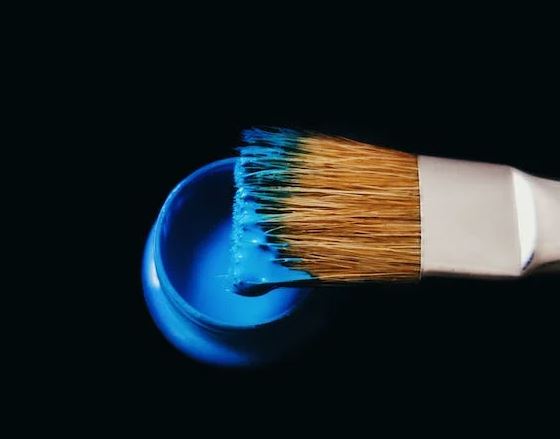A Concord, CA area interior commercial painting project demands more than just a fresh coat of paint—it involves a careful selection process, considering factors like durability, aesthetics, and the demands of different surfaces. When you jump into the world of commercial paints, it unveils a diverse range of options, each with unique traits.
Understanding these paint types, their applications, and the factors influencing their selection is crucial to achieving an impeccable finish that looks good and stands the test of time. In this comprehensive guide, we’ll take you through the landscape of commercial paints, offering insights into their properties, suitability for different surfaces, and the considerations essential in making informed decisions for your next commercial painting endeavor.
Common Types of Commercial Paints
Commercial painting projects in the Walnut Creek area often involve various paint types tailored to specific surfaces and environmental demands, such as:
1. Latex Paints
Latex paints have become popular in commercial painting for their versatility and eco-friendliness. These paints consist of pigments suspended in a water-based solution, making them easy to clean up with water and soap, thereby reducing exposure to harsh chemicals.
One of the primary advantages of latex paints is their quick drying time, allowing for faster recoating and speeding up project timelines significantly.
These paints offer exceptional durability, resisting cracking and peeling over time, and they provide excellent color retention even in high-traffic areas. Latex paints come in various finishes, from flat to glossy, catering to diverse aesthetic preferences and functional needs. Additionally, they are ideal for interior spaces due to their low odor and low volatile organic compound (VOC) content.
2. Oil-based Paints
Oil-based paints have long been a staple in commercial painting in the Pleasant Hill, CA area due to their durability and excellent adhesion properties. These paints are made with a blend of pigments suspended in an oil base, usually linseed oil or alkyd resin. One of their primary advantages is their robustness, offering a hard and durable finish that withstands wear and tear, making them suitable for high-traffic areas and exteriors.
These paints provide a smooth and lustrous finish. They are known for their excellent flow and leveling, which results in a consistent coat, especially on trim and woodwork. Oil-based paints also offer superior moisture resistance, making them suitable for surfaces exposed to high humidity or moisture. However, they have a longer drying time than latex paints and typically require mineral spirits or turpentine for cleanup, which can increase the presence of VOCs in the environment.
3. Epoxy Paints
Epoxy paints, made of epoxy resins and hardeners, are exceptionally durable coatings used in areas prone to wear and tear. They create strong, chemical-resistant surfaces, ideal for heavy-use spaces like industrial sites and garages. Their glossy finish and resistance to stains and moisture make them great for easy cleaning.
However, they need precise surface preparation and have limited color options, being more expensive and susceptible to yellowing in sunlight over time.
4. Anti-graffiti Paints
Anti-graffiti paints are specialized coatings designed to prevent graffiti or make it easier to remove them. They provide a protective layer that allows easy cleaning of painted surfaces, deterring vandals and preserving the original surface. These paints come in sacrificial and non-sacrificial varieties.
Sacrificial anti-graffiti paints allow the graffiti to be removed by stripping the top layer, while non-sacrificial coatings allow cleaning without removing the coating itself. They effectively protect public spaces, buildings, and structures, maintaining their aesthetic appeal while minimizing maintenance costs. However, their effectiveness may vary based on the type and frequency of graffiti. Moreover, they might also require reapplication to remain effective.
5. Low VOC and Green Paints
Low VOC (Volatile Organic Compound) and green paints are environmentally friendly alternatives to traditional paints. They contain fewer harmful chemicals, hence less emission of volatile organic compounds into the air, which might contribute to indoor air pollution and health issues. These paints use water as a base instead of petroleum-based solvents, making them low in odor and environmentally safe. They contribute to healthier indoor air quality and are suitable for spaces where occupants, such as children or those sensitive to strong odors, are present.
Green paints often carry certifications like LEED (Leadership in Energy and Environmental Design) or comply with specific environmental standards, ensuring they meet certain eco-friendly criteria. While they offer health and environmental benefits, some variations might require additional coats or have limitations in terms of color selection and durability compared to conventional paints.
6. Enamel Paints
Enamel paints are known for their durability and glossy finish, making them a popular choice for various surfaces in commercial settings. They are oil-based or water-based paints that form a hard, protective coating once dry, providing excellent resistance against moisture, stains, and wear. This type of paint is versatile and suitable for varied materials, including metals, wood, and certain plastics.
Enamel paints come in various finishes, from high gloss to satin or matte; each offers flexibility in achieving different aesthetic looks. They are often used in high-traffic areas or surfaces prone to frequent cleaning due to their robust nature and ability to withstand abrasion. However, enamel paints can have a strong odor during application and require proper ventilation. Additionally, they may take longer to dry compared to other paint types.
7. Alkyd Paints
Alkyd paints are oil-based paints known for their durability and excellent adhesion properties. They contain alkyd resins, which make them highly durable, providing a tough and protective coating when dry. These paints work well on various surfaces, including wood, metal, and masonry, making them versatile for different commercial applications.
Alkyd paints dry to a smooth and hard finish; they offer resistance against moisture, abrasion, and harsh weather conditions. They are available in various sheens, from glossy to satin or matte, allowing for diverse aesthetic preferences in commercial spaces. One of the drawbacks of Alkyd paints is their slow drying time, which can extend the project timeline.
Additionally, they produce strong fumes during application, necessitating proper ventilation, and may require mineral spirits for cleanup. Despite these considerations, their durability and finish quality make them a preferred choice for many commercial painting projects.
8. Textured Paints
Textured paints are specially formulated to add dimension and depth to surfaces, which provides an aesthetically pleasing finish. They contain additives like silica or sand that create texture when applied, resulting in unique patterns or rough surfaces. These paints are versatile and can be used to hide imperfections on walls or ceilings.
They come in various textures, such as sand, popcorn, or stipple, so you can easily customize your own designs. Textured paints can cover minor surface flaws and are suitable for areas that undergo heavy wear and tear. However, they can be challenging to apply evenly and may require specific application techniques to achieve the desired texture. Additionally, matching textures for touch-ups or repainting can be difficult, requiring careful attention to maintain consistency across the painted surface. Overall, textured paints offer a creative way to enhance the look and feel of commercial spaces, but their application may require additional skill and effort compared to regular paint.
Factors Influencing Paint Selection
Choosing the right paint for a commercial project involves considering several crucial factors that can significantly impact the outcome, such as:
Surface Material
The type of surface being painted plays a pivotal role in selecting the appropriate paint. For instance, different paints suit various surfaces—wood, metal, concrete, or drywall. Each surface demands specific adhesion and durability, influencing the choice of primer and paint.
Environmental Conditions
Environmental factors in the Lafayette, CA area, such as temperature fluctuations, humidity levels, and exposure to direct sunlight, influence paint durability. Areas with high moisture levels might require moisture-resistant paints, while spaces prone to direct sunlight may need UV-resistant coatings to prevent color fading or degradation.
Purpose of the Space
It is important to determine the function of the area being painted. Paints with high durability and easy-to-clean surfaces are preferable for high-traffic zones like corridors or lobbies. For office spaces or retail areas, paints that enhance ambiance and are visually appealing are usually chosen.
Budgetary Constraints
The budget plays a significant role in paint selection for commercial projects. Different types of paints vary in cost, and while some may offer superior durability and performance, they might cost much more. Balancing quality with budget constraints is essential to ensure optimal results within the allocated financial scope.
Application Techniques
Proper Surface Preparation
For a successful commercial painting project, employing proper application techniques is as crucial as selecting the right paint. Surface preparation is the initial step, involving thorough cleaning, priming, and repairing any imperfections or cracks on the surfaces to ensure better paint adhesion and durability. Cleaning removes dirt, dust, and debris while priming seals porous surfaces and enhances paint adhesion.
Selecting the Right Tools is Equally Vital
Brushes, rollers, or sprayers are commonly used in commercial painting projects. Brushes allow precision and accuracy, ideal for intricate areas or detailed work. Rollers cover larger surface areas efficiently and uniformly, ensuring a smooth finish. On the other hand, sprayers are adept at covering large spaces quickly, making them suitable for extensive projects.
Choosing the appropriate application tool depends on the project’s specific needs, the type of surface, and the desired finish, ensuring an optimal and professional result.
Conclusion
Selecting the right paint for commercial spaces involves many factors that directly impact the durability and aesthetics of the final finish. Considering factors such as surface material, environmental conditions, space utility, and budget constraints can influence the choice of paint type.
However, professional expertise plays an essential role in the complex realm of commercial painting. Expert contractors bring years of experience, specialized knowledge, and precision in executing every project phase. Their guidance in selecting the appropriate paint and adept application techniques ensure a superior and long-lasting finish. Collaborating with seasoned professionals not only ensures a seamless painting process but also guarantees the best possible results that align with your project’s needs and goals.
Contact Custom Painting, Inc. today to discuss your commercial painting needs. You can use the Contact Form or by calling 925-686-0903.






